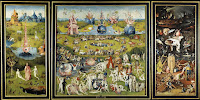 |
| The Elevation of the Cross (1610) by Peter Paul Rubens |
Pronunciation of Triptych
Many people get confused about the pronunciation of the word ‘triptych’. The reason is simply that root of the word has greek origin. Triptychos (Τριπτυχος) comes to mean of ‘three layered painting’ in english and it is spelled like ‘trip-tick’. Triptychs generally contain three dividual paintings arranged in a row.Purpose of Using
 |
| Mérode Altarpiece (1428) by Robert Campin |
 |
| The Garden of Earthly Delights (1503-1515) by Hieronymus Bosh |
What is Triptych?
 Reviewed by Articonog
on
December 22, 2019
Rating:
Reviewed by Articonog
on
December 22, 2019
Rating:
 Reviewed by Articonog
on
December 22, 2019
Rating:
Reviewed by Articonog
on
December 22, 2019
Rating:





No comments: